Investing
Trump’s tariff policies pose ‘minimal’ risk to derail Vietnam’s growing economy
Published
10 months agoon
Vietnam was Asia’s biggest beneficiary of the first Trump administration. While Trump 2.0 will probably not be as beneficial to Vietnam as Trump 1.0 was, there is “minimal risk” that Trump’s tariff policies will derail Vietnam’s growing economy – in sharp contrast to claims made in some articles published since his election, writes Michael Kokalari, chief economist at VinaCapital.

Michael Kokalari, chief economist at VinaCapital. Photo courtesy of the company.
Last week, Trump picked the best possible Treasury Secretary for Vietnam, Scott Bessent, who has repeatedly said Trump’s tariff proposals are “maximalist” positions that would likely be watered down in negotiations; Trump’s recent announcement that he intends to impose 25% tariffs on Canada and Mexico should probably be viewed in that vein.
More importantly for Vietnam, Bessent favors considering US geopolitical objectives when determining tariff levels on individual countries. The details of how exactly this could function as well as other specifics of Trump’s likely tariff strategy are outlined in a white paper titled “A User’s Guide to Restructuring the Global Trading System”, which circulated widely after Trump’s election, and was written by a senior economic policy advisor in Trump’s first administration and who holds an economics PhD from Harvard University and is reportedly close to Bessent.
That 40-page report mentions considering geopolitical factors to determine tariffs on individual countries over 20 times. In short, the bipartisan belief in Vietnam’s usefulness to the U.S. to help it achieve its geopolitical objectives essentially ensures that Vietnam will not be singled out for overly harsh tariff treatment by Trump.
Before the Biden administration came into office, there were many concerns that Vietnam would not fare as well under Biden as it had during the Trump-instigated, U.S.-China trade war. The January 2021 publication of the Atlantic Council’s “The Longer Telegram” dispelled those concerns and made it clear that the U.S.-Vietnam relationship would continue to strengthen under Biden.
We have highlighted both of these policy papers because the 2021 “Longer Telegram” report was a preview of the Biden administration’s stance towards Vietnam (which we characterize as “unambiguously positive treatment”) and the 2024 “User’s Guide” report hints at how Vietnam is likely to be treated by the next Trump administration (we expect “neutral to slightly positive” treatment).
Finally, the “User’s Guide” policy paper details how tariffs could be used to encourage the re-shoring of manufacturing jobs back to the U.S. via a sophisticated strategy that would resemble the 1985 “Plaza Accord” agreement to weaken the U.S. dollar but that would also strengthen the dollar’s role as the world’s reserve currency.
Media pessimism
Trump’s re-election prompted several international business publications to warn that his tariff policies could drastically derail Vietnam’s economy. Articles with titles such as, “A Rough Four Years Await Vietnam” were published and claims that “Vietnam’s economic growth – which was 5% last year – could shed up to 4 percentage points” were published and were, in our view, extremely pessimistic because the assertions were not accompanied with any evidence to explain why Vietnam would suffer such a severe decline in GDP.
One article published by a prominent newspaper asserted that South Korean firms might delay or reduce their investments in Vietnam if Trump were to proceed with his plans to put 10-20% blanket tariffs on all countries (ex-China).
But investments by major Korean companies continue to flow into Vietnam because factory wages in Korea are nearly 10x those in Vietnam, and Korea is ageing at a faster pace than Japan did at the peak of its demographic decline. Companies are unlikely to change plans to produce in Vietnam if exports from Korea and Vietnam to the U.S. were to suffer from the same tariff burdens, and it is possible that Vietnam may even get favorable tariff treatment vis-à-vis its Asia exporting peers under Trump.
Further to that last point, the common thread between “The Longer Telegram” and “User’s Guide” policy papers is that geopolitical considerations should shape U.S. economic relationships with countries around the world.
That is ideal for Vietnam because of the country’s adept “Bamboo Diplomacy” strategy of befriending both China and the US/Friendshoring cohort of countries (The Longer Telegram is a deep discussion of the intertwining of US geopolitical and economic strategy in Asia – which has been characterized as a “New Washington Consensus” that will continue under Trump).
Vietnam is well positioned – with some caveats
On November 7, we published this report titled “Trump’s election should have little impact on Vietnam”, in which we opined that Vietnam can be helpful to wean the U.S. off of China-made goods which cost too much to manufacture at home.
Last week, this article in Forbes quoted a supply chain expert who said, “If previously it was made in China, now it’s going to be made in Vietnam” because “production is not coming back to America.” Another article quoted the CEO of Black and Decker, who said his company is unlikely to move manufacturing jobs back to the U.S. because “it’s just not cost effective.”
The Forbes article also quoted a U.S.-based economist who essentially said he expects China to continue moving factories to Vietnam during Trump’s administration. We agree, but Vietnam’s FDI inflows could fall somewhat next year because it will take some months before it becomes clear what Trump will actually do on tariffs.
There’s also a possibility that the U.S. will clamp down on Chinese factories moving to Vietnam at some point in the future, but we expect the Trump administration’s initial focus will be on imports from China and on products produced by Chinese companies in Mexico.
Mexico will come under considerable scrutiny because of U.S. voter concerns about illegal immigration and speculation about the degree to which Mexico is helping China circumventing U.S. tariffs (a recent report by the Rhodium Group titled “A Closing Back Door?” asserted that “Chinese FDI in Mexico is significantly higher than shown in official statistics”).
In contrast, according to recent Harvard University research, the amount of re-routing of Chinese products to the U.S. via Vietnam (in order to circumvent tariffs) may be as low as about 2% of Vietnam’s total exports to the U.S. That said, U.S. trade officials will likely insist on more stringent mechanisms to prevent transshipment via Vietnam in exchange for lenient tariff treatment.
Understanding Trump’s objectives & strategy
Donald Trump wants to re-shore manufacturing jobs back to the U.S. Trump was very vocal about his intention to use tariffs to achieve that objective throughout his campaign – although the threat to impose tariffs on China also appealed to one of his key constituencies: disaffected blue-collar workers.
The bare bones essence of Trump’s likely tariff strategy is using tariffs to:
1) Compel China, Germany, etc. to build factories in the U.S., and
2) Compel widespread cooperation for a “Plaza Accord 2.0” to depreciate the USD by about 20%
The latter would encourage the re-shoring of jobs to the U.S. and would be good for Vietnam because the State Bank of Vietnam has loosely pegged the VND exchange rate to the U.Sdollar (a cheaper VND would unambiguously boost Vietnam’s export competitiveness to the rest of the world).
Note also that Bessent and others advocate implementing tariffs gradually to avoid market dislocations and/or boosting U.S. inflation (for example, an initial 2% tariff could be imposed on a country with the threat of increasing those tariffs by 2% pts per month).
Other aspects of the strategy are detailed in the “User’s Guide” report, which we have summarized separately. The original report, which is fairly technical, can be found on the website of Hudson Bay Capital, a $31 billion hedge fund where the author, Stephen Miran, is a senior strategist; he previously served as Trump’s senior advisor for economic policy at the U.S. Treasury Department and is reportedly close to the U.S. Treasury Secretary nominee Scott Bessent.
We should also mention that Miran characterizes the report as a summary of the economic tools available to the Trump administration to achieve major re-shoring of manufacturing jobs. However, we believe this report should be viewed as a preview of the incoming administration’s likely tariff policies and strategy, which are likely to be more sophisticated and nuanced than most mainstream media have given Trump credit for given their perceived bias during the campaign.
Recognizing the risks
We believe the strategy described above – using tariffs as a negotiation strategy to help bring manufacturing jobs back to the U.S. – will be economically neutral to Vietnam at worst for several reasons.
However, we need to recognize the fact that Trump’s negotiation and communication style during his first term was erratic, and consequently, we are concerned that his off-the-cuff comments and social media posts could impact stock markets around the world – including Vietnam’s.
That said, it is possible that markets will be more immune to Trump’s bombastic rhetoric this time around. In the past, venture capitalist Peter Thiel said that Trump should be taken “seriously, but not literally,” and a research report published by Barclays last week echoed that sentiment. Even the Nikkei article we mentioned above (“A Rough Four Years Await Vietnam”) admitted that “Trump’s bark was worse than his bite.”
Next, most of the announced members of Trump’s incoming economics team have expressed reticence about imposing large tariffs on U.S. trading partners. For example, Kevin Warsh, who teaches at Stanford University and is likely to be the next Fed Chairman, wrote an op-ed in the Wall Street Journal some years ago advising policy makers to “resist the rising tide of economic populism” at that time. Our biggest concern is that the economic strategy discussed above gets derailed by infighting or by resignations, bearing in mind the extreme turnover of senior staff in Trump’s first administration.
Vietnam specific risks
All of that said, the most immediate risk for Vietnam’s stock market (and all emerging stock markets) is the possibility of a continued increase in the value of the U.S. dollar. The USD/DXY Index surged by about 7% in the lead-up to and aftermath of the election, driven in-part by tariff concerns (the “User’s Guide” strategy includes a “Plaza Accord 2.0” agreement to offset a tariff-driven stronger USD).
The USD-VND exchange rate depreciated by nearly 5% year to date as of this writing and would certainly pass the psychologically important 5% year to date level were the DXY to continue climbing, prompting the SBV to tighten monetary policy/raise interest rates to support the VND.
Finally, Vietnam’s circa $100 billion trade surplus with the U.S. is the third largest of any single country after Mexico and Canada. To put that figure in context, the U.S. Treasury Department has three criteria for a country to be considered a “Currency Manipulator”, one of which is persistent trade surpluses of over $30 billion.
For this and other reasons (i.e., Trump is very focused on the numerical trade balance between the U.S. and its trading partners), the Vietnamese need to take urgent steps to reduce its trade surplus with the U.S. by purchasing more products from the U.S. (e.g., LNG, aircraft jet engines, etc.). Bloomberg recently reported some encouraging initial indications that this is likely to happen.
Conclusions
The second Trump administration will probably not be as beneficial to Vietnam’s economy as the first one was, but we see minimal risk that Trump’s tariff policies will derail Vietnam’s healthy economic trajectory – in contrast to the warnings of a plethora of pessimistic newspaper articles. Trump’s announced economic team mostly view tariffs as a negotiation tool.
Furthermore, it looks likely that the incoming Trump administration will take geopolitical considerations into account when determining tariffs for individual countries; this will be good for Vietnam, given bipartisan agreement that it is useful to the U.S. to achieve its regional geopolitical objectives.
You may like
-


Vietnam’s Exclusive Economic Zone boasts over 1,000 GW of wind power potential: report
-
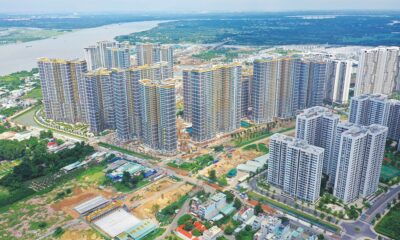

Uncertainty weighing on real estate
-
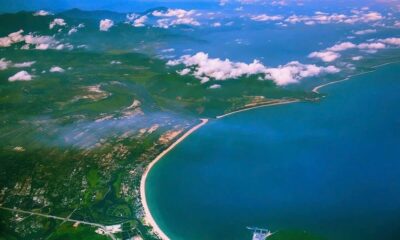

Central Vietnam city seeks $1.84 bln for 15 projects in economic zone
-
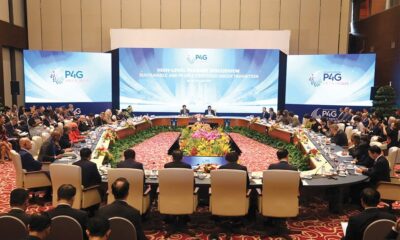

Green engagement rides high in Vietnam
-
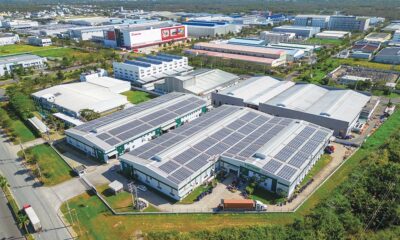

New standards being reached within green industrial parks
-
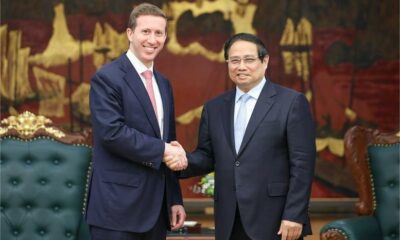

Vietnam PM asks Warburg Pincus to invest ‘further and faster’
Investing
Bac Giang International Logistics Centre launched
Published
8 months agoon
April 27, 2025Bac Giang International Logistics Centre was launched on April 22 with an investment of $168 million, and is expected to become a crucial link in the global supply chain.
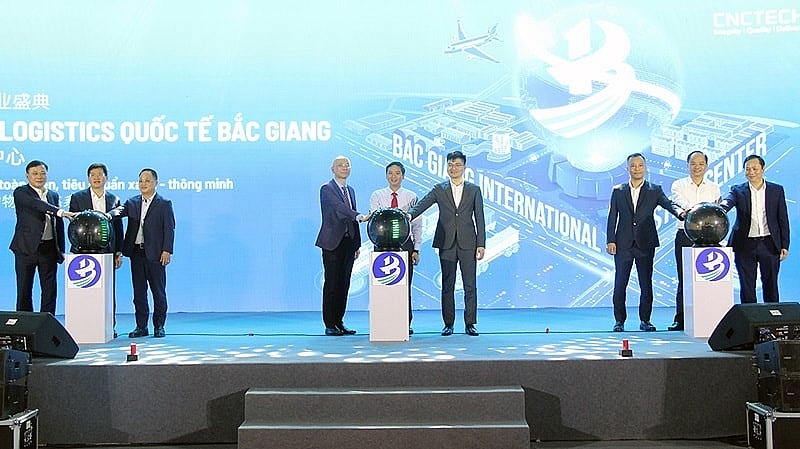 |
| Bac Giang International Logistics Centre launch |
Being invested by CNCTech Group, Dolphin Sea Air Services Corporation and Thien An Investment JSC, the logistics centre is located on National Highway 1A, which boasts first-class warehouse supply to meet the growing demand in the northern Vietnamese market.
Its strategic position within the golden economic triangle of Hanoi – Haiphong – Quang Ninh provides convenient connectivity to industrial zones and key logistics centres via national highways No.1A and No.37.
The centre is designed to meet growing demand for logistics infrastructure from businesses in Bac Giang and neighbouring provinces, positioning the area as a new node in northern Vietnam’s logistics network.
The project is a strategic product as a key component of the logistics spearhead in CNCTech Group’s industrial and logistics infrastructure ecosystem. It has been approved by the prime minister as a national level-II logistics centre, covering a planned area of 67 hectares.
At the launch ceremony, Chairman of Bac Giang People’s Committee Nguyen Viet Oanh said, “In recent years, the province’s socioeconomic development has made remarkable strides. Transportation, urban, industrial, and social infrastructure have been synchronously invested in and have yielded high efficiency. However, the province’s logistics service sector has not yet matched its potential, advantages, and socioeconomic development level. The logistics system remains fragmented, transportation costs are high, and trade delivery times are prolonged.”
Recognising this bottleneck, the local authorities have focused on directing the robust development of the logistics system, incorporating it into the provincial plan. This includes developing eight comprehensive logistics centres covering nearly 500ha, three inland container depots, and 33 inland waterway ports.
“Bac Giang, with its strategic location between Hanoi and border provinces, has long been known as a dynamic industrial hub. The remarkable development of the province’s industrial parks has created a solid foundation for the establishment of Bac Giang International Logistics Centre. This centre is not only located on vital transportation routes such as Hanoi-Lang Son Expressway but also directly connects to major border gates, optimising the transport of goods from Bac Giang to the world,” said Oanh.
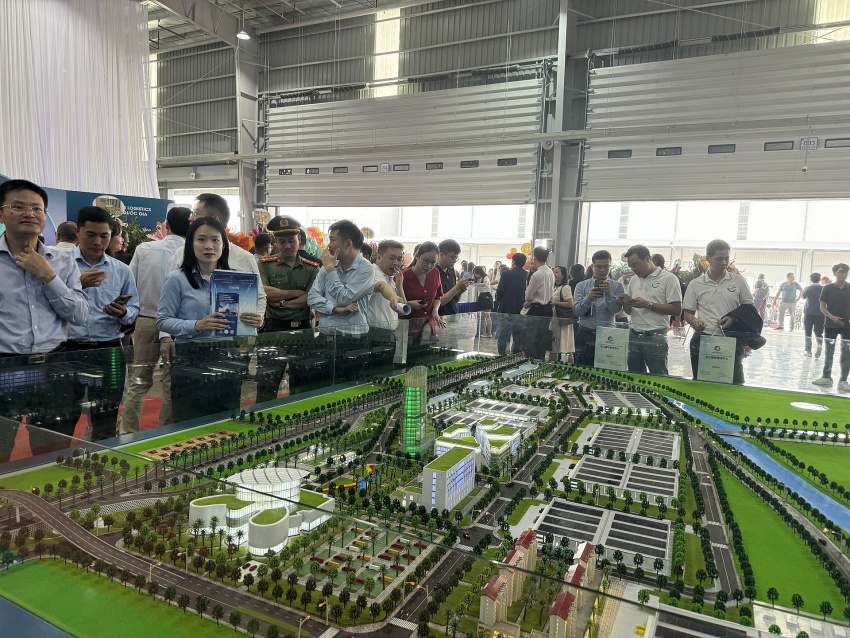 |
| A model of the logistics centre |
The project is not merely a warehousing facility, but also a symbol of the integration of modern infrastructure and advanced technology. The centre includes multifunctional warehouse areas, customs-controlled warehouses, non-tariff warehouses, and automated warehouses, meeting the needs of various industries. Notably, it integrates end-to-end logistics solutions, supporting businesses in optimising transportation costs and enhancing production efficiency.
With a long-term vision, the centre aims not only to optimise domestic supply chains but also to become a key connection point in the global logistics network.
Nguyen Van Hung, chairman of the Board of Members of CNC Tech Group, shared, “The establishment of this centre is a strategic step in developing Vietnam’s logistics infrastructure. We are committed to long-term and robust investment in this sector, as logistics is not just infrastructure but an indispensable part of enhancing the competitiveness of Vietnamese businesses on the international stage.”
Vietnam has taken strong action to promote green development among businesses, amid the country facing challenges in finance and technology.
Vietnamese Party General Secretary To Lam told the fourth Summit of the Partnering for Green Growth and the Global Goals 2030 (P4G), organised last week in Hanoi, that Vietnam is focused on strategic breakthroughs to prepare for a national development process that is fast, inclusive, and sustainable.
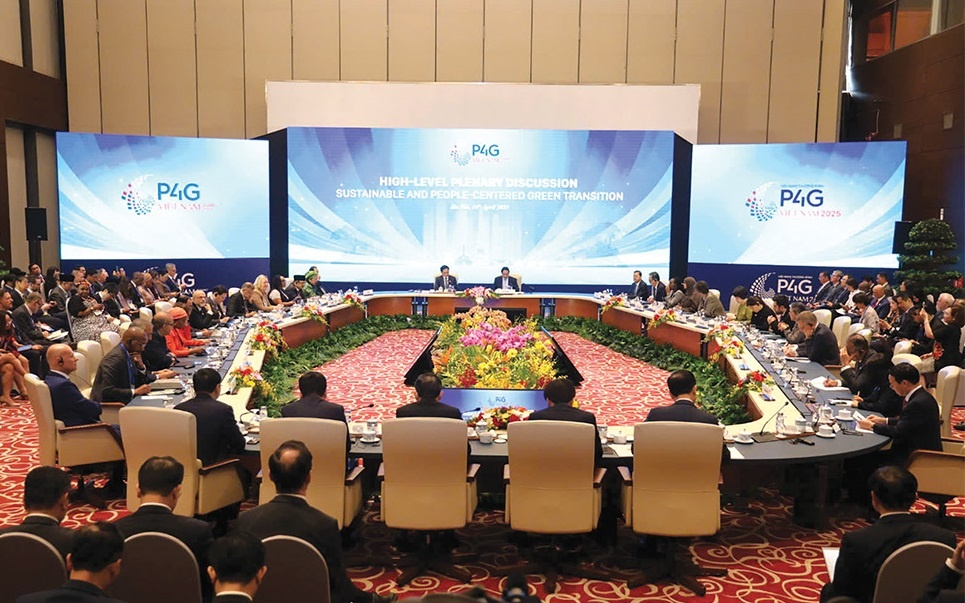 |
| The summit in Hanoi covered areas from finance and banking to agriculture and technology Photo: Dung Minh |
“We will strongly transform political commitments into practical actions, creating motivation for businesses and the whole society to participate in sustainable economic development, in which green institutions are the decisive foundation,” General Secretary Lam stressed at a hall attended by government leaders, UN representatives, diplomats, experts, and entrepreneurs.
General Secretary Lam also stressed that when it comes to green transformation, despite being a developing country with a transitional economy and limited resources, Vietnam has achieved some important results.
Besides making a 2050 net-zero commitment in 2021, Vietnam also endorsed six global initiatives at the time, on forest and land use, methane, clean power transition, sustainable food and agriculture, and more.
“Vietnam is now a leading country in supplying renewable energy in ASEAN, with wind and solar power capacity accounting for two-thirds of ASEAN’s total capacity,” he said.
“Additionally, Vietnam is also a good example of encouraging sustainable agriculture. The initiative to develop one million hectares of high-quality and low-emission specialised rice is a pioneering model that many partners and international organisations are interested in.”
A greener future
Vietnam is an active and responsible member of all multilateral mechanisms and major initiatives on green growth and energy transition such as the Paris Agreement on climate change, the Just Energy Transition Partnership, and the P4G.
“However, as a developing country with a transitional economy, we also face many challenges in terms of financial resources, technology, personnel, and resilience to the impacts of climate change and geopolitical fluctuations globally,” said General Secretary Lam.
The summit adopted the Hanoi Declaration, strongly affirming commitments to sustainable growth with people at the centre, and a determination to collaborate responsibly in addressing current global challenges. Vietnam is expected to enjoy continued support from the international community in its journey to a green economy including energy transition.
According to the World Bank, to ensure sufficient funding for responding to climate change, mobilising domestic finance is possible, but external support is needed.
Overall, Vietnam’s total incremental financing needs for the resilient and decarbonising pathways could reach $368 billion over 2022–2040, or approximately 6.8 per cent of GDP per year.
The resilient pathway alone will account for about two-thirds of this amount, as substantial financing will be required to protect the country’s assets and infrastructure as well as vulnerable people.
The cost of the decarbonising pathway will mainly arise from the energy sector – investments in renewables and managing the transition away from coal might cost around $64 billion between 2022 and 2040. All the figures are in net present value terms at a discount rate of 6 per cent.
This $368 billion in financing needs will include $184 billion from private investments or about 3.4 per cent of GDP annually, $130 billion or about 2.4 per cent of GDP annually from the state budget; and $54 billion or about 1 per cent of GDP per year from external sources.
Choi Youngsam, South Korean Ambassador to Vietnam, said that within the P4G framework, South Korea and Vietnam have completed or are currently implementing joint projects in areas such as food and agriculture, energy, water, and urban development.
“Looking ahead, both sides are expected to broaden and deepen their partnership under the P4G framework,” he said.
At the P4G Summit held in Seoul in May 2021, the two governments signed the Framework Agreement on Cooperation in Response to Climate Change, laying a solid policy foundation for the implementation of international emissions reduction ventures.
“On this basis, I hope that South Korea will leverage its technological expertise and financial resources to carry out greenhouse gas emission reduction projects in Vietnam, with both countries mutually recognising the results,” Ambassador Youngsam said.
“This would contribute to establishing a win-win model of emissions reduction cooperation. At the same time, I look forward to seeing active engagement from South Korean enterprises possessing green technologies, in close collaboration with the Vietnamese government.”
Encouraging developments
Deputy Minister of Science and Technology Hoang Minh said at a policy dialogue on the sidelines of the P4G 2025 that the active participation and strong cooperation from stakeholders – from the public and private sectors to international organisations – can help materialise Vietnam’s aspiration of an efficient and sustainable innovative startup ecosystem.
“Innovation, creative entrepreneurship and collaboration are key to solving environmental problems, while encouraging the development of a circular economy,” he said.
Vietnam currently has over 4,000 innovative startups, including two unicorns valued at over $1 billion, 11 companies valued at over $100 million, more than 1,400 startup support organisations, 202 co-working spaces, 208 investment funds, and 35 business promotion organisations. Among these, it is estimated that around 200–300 companies focus on green transition, covering areas such as renewable energy, environmental technology, sustainable agriculture, and the circular economy.
According to the Vietnamese Ministry of Foreign Affairs, hosting the fourth P4G Conference is of great significance to Vietnam. It is aimed to boost its role as a good friend, a reliable partner, and a responsible member of P4G and the international community. Moreover, it is also aimed to reaffirm its commitment to sustainable development, energy transition, and the goal of carbon neutrality by 2050. Besides that, it is aimed at contributing to raising awareness of international cooperation and encouraging the role and voice of developing countries in the sector of green growth and sustainable development.
| Pham Minh Chinh, Prime Minister
For Vietnam, together with digital transformation, we identify green transition as an objective necessity, a key factor, and a breakthrough driving force to promote rapid growth and sustainable development. This aligns with the strategic goal of becoming a developing country with modern industry and upper-middle income by 2030, and a developed, high-income country by 2045, while also contributing to the gradual realisation of Vietnam’s commitment at COP26 to achieve net-zero emissions by 2050. From practical experience with initial positive results, especially in renewable energy, green agricultural development, and participation in multilateral mechanisms and initiatives on green transformation, as the host of the fourth P4G Summit, Vietnam has three suggestions for discussions which pave the way for further cooperation in the coming time. First is to perfect green mindset, with a focus placed on the development of science and technology, innovation, and digital transformation linked to green growth. This includes recognising that green resources stem from green thinking, green growth is driven by green transition, and green resources arises from the green awareness of people and businesses in nations and regions throughout the world. Second is to build a responsible green community, in which, the government plays a guiding role, encouraging, and ensuring a stable and favourable institutional environment for green growth. The private sector functions as a core investor into technological development and the dissemination of green standards. The scientific community take the lead in developing green technologies and training green human resources. Meanwhile, citizens continuously enhance their green awareness, truly becoming beneficiaries of the outcomes of green transformation. Thirdly, it is necessary to promote international cooperation and robust multilateral green cooperation models, particularly public-private partnerships, South-South cooperation, North-South cooperation, and multilateral cooperation frameworks. This is aimed at removing institutional barriers, enhancing access, and speeding up the flow of green capital, green technology, and green governance. Developed countries should take the lead in fulfilling commitments to provide financial, technological, and institutional reform support. Meanwhile, developing countries would need to leverage their internal strengths and effectively utilise external resources. |
Investing
Public-private partnerships a lever for greener innovation
Published
8 months agoon
April 26, 2025Public-private partnerships are no longer a supporting mechanism, but a strategic pillar in the global pursuit of the green transition.
The high-level dialogue between government leaders and businesses at the 2025 P4G Vietnam Summit last week, chaired by Prime Minister Pham Minh Chinh, brought together senior officials, global experts, international organisations, and private sector leaders.
They recognised that the climate crisis, digital transformation, and resource depletion are converging in ways that demand not only innovation, but deep and long-term collaboration between the public and private sectors.
UN Deputy Secretary-General Amina J. Mohammed acknowledged Vietnam’s leadership in renewable energy, noting its potential to attract trillions in sustainable investment.
“Emerging economies must accelerate the adoption of new investment models, particularly those that align private capital with green infrastructure priorities. Governments must work with the private sector to expand ambition, strengthen accountability, and deliver real impact,” she said.
From Italy, Prime Minister’s Climate Envoy Francesco Corvaro stressed that public-private partnerships (PPPs) are indispensable in addressing climate finance gaps. Drawing from Italy’s experience, he underscored the importance of public investment as a risk mitigator, enabling private sector participation in clean energy and smart infrastructure projects.
“Public investment can unlock private capital, but local authorities must lead with clear priorities and long-term vision,” Corvaro noted. “You can’t talk about renewables, AI, or digital infrastructure without modern, resilient grids, and that requires strong public-private alignment.” he said
Alejandro Dorado, Spain’s High Commissioner for Circular Economy, argued that the case for stronger PPPs lies at the intersection of two accelerating forces: the environmental-climate crisis and a wave of disruptive technologies.
“In a world where AI, green technologies, and digitalisation are reshaping the global economy, the clock is ticking. According to the Intergovernmental Panel on Climate Change, we have less than a decade to prevent irreversible climate disaster. Meanwhile, the World Economic Forum has identified biodiversity loss as one of the most severe economic risks,” he said.
 |
Dorado added that while multilateralism is being questioned or weakened in some quarters, the need for cooperation has never been more urgent – both to solve environmental challenges and to harness the transformative potential of innovation.
“No government or business can tackle these crises alone. Public authorities must provide the regulatory frameworks, fiscal incentives, and infrastructure deployment needed at scale to safeguard the common good,” he stressed.
From the business side, Stuart Livesey, country representative of Copenhagen Infrastructure Partners (CIP), provided a frank but optimistic outlook. Livesey stated CIP’s commitment to supporting Vietnam’s transition, but emphasised the need for enabling conditions.
“What we seek are clear, bankable projects underpinned by stable regulatory frameworks, collaborating with strong local partnerships. This is where public-private cooperation becomes not just helpful, but essential,” Livesey noted. “Over the next 10-15 years, the offshore wind sector and green energy consumers will trigger massive demand for new technologies, digital solutions, and skilled labour.”
To meet this demand, CIP is investing not only in infrastructure, but also in capacity building, research and development, and local supply chain development through partnerships with Vietnamese universities.
Still, he acknowledged barriers. “Technological application and innovation in green projects face challenges, from long-term financing constraints and skilled labour shortages to fragmented policy signals. These are not unique to Vietnam, but they require proactive, tailored local solutions,” he said. “Addressing issues such as grid availability, regulatory clarity, and inter-ministerial coordination will be critical.”
Tim Evans, CEO of HSBC Vietnam, stated that the banking sector is ready to facilitate green finance, particularly in sectors aligned with national climate targets.
“We see ourselves as a bridge between global capital and local sustainability goals. The clearer the pipeline of bankable, climate-aligned projects, the faster we can move capital,” he noted. “What’s crucial now is consistency in policy and coordination among stakeholders to ensure these projects reach maturity.”

Bac Giang International Logistics Centre launched

Vietnam’s Exclusive Economic Zone boasts over 1,000 GW of wind power potential: report

Uncertainty weighing on real estate

Central Vietnam city seeks $1.84 bln for 15 projects in economic zone

